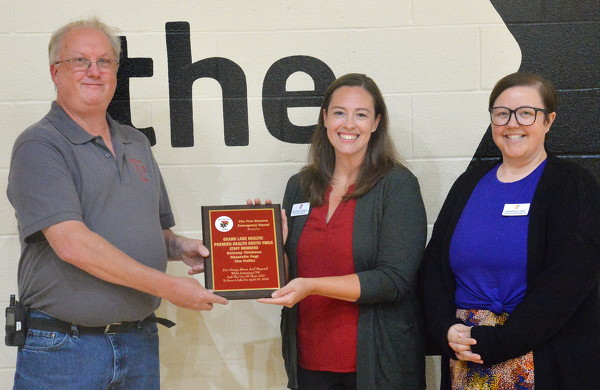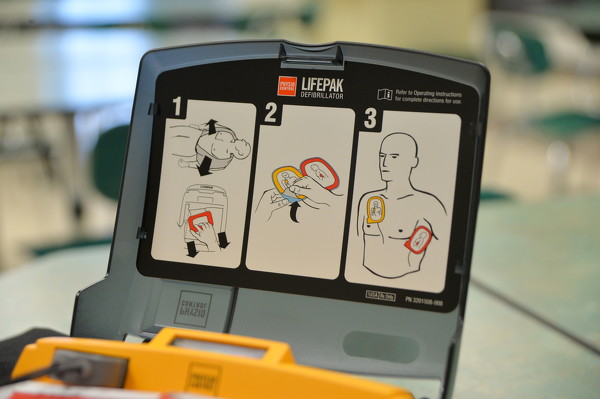Wednesday, June 14th, 2023
YMCA staffers lauded for saving life
By William Kincaid

Photo by William Kincaid/The Daily Standard
Larry Weimert, president of New Bremen Emergency Medical Services presets a plaque to Brittany Thiebeau, Shatelle Fogt, and not pictured Tim Pollitz. The trio of YMCA staff saved the life of a patron through the use of CPR and an automatic emergency defibrillator (AED).
MINSTER - Three staff members of Grand Lake Health/Premier Health Southwest YMCA are being hailed as heroes for saving the life of a patron through a combination of CPR and an Automatic Emergency Defibrillator (AED).
Larry Weimert, president of New Bremen Emergency Medical Services, on Monday afternoon presented a plaque to Brittany Thiebeau and Shantelle Fogt for going above and beyond to save a life at the YMCA on April 10. The third staff member, Tim Pollitz, was absent.
Weimert had also responded to the incident as a paramedic. By the time EMS arrived, the staff members had revived the man.
"They were well trained. They actually have a plan and they used that plan to perfection," Weimert said. "They did their job to perfection."
At roughly 2:30 p.m. April 10, a male patron working out on a chest machine slumped to the floor of the weight room. He was believed to be experiencing cardiac distress.
That's when countless hours of training, pure instinct and racing adrenaline took over three staff members who executed YMCA's well-rehearsed emergency action protocols.
"We were alerted by a member that one of our patrons was down in the weight room and we ran into action," said Fogt, the senior aquatics director.
Thiebeau, the executive director, ran into the weight room first, followed by Fogt with an AED and Jared Butcher, the membership director, with a bag containing supplies, Fogt said. A call was also made to 911.
"We noticed that he was not responding, and he had a very faint to no pulse at all so that meant for us to immediately start CPR," Thiebeau said. "I started chest compressions as she got the AED ready to go and then we started rescue breathes. It took probably less then 10 seconds to get the AED on him and then we immediately listened to the instructions of the AED."

File Photo/The Daily Standard
Automatic Emergency Defibrillators come with vocal commands and diagrams.
An off-duty lifeguard working out in the weight room helped with the rescue breathes, Fogt noted.
"We traded in and out with the compressions and I had the AED so I helped get that started and we ended up shocking him four times," she said.
"As a part of our process, as you are doing CPR you get that AED on because you don't know if you need to use the AED or not," Thiebeau said. "It will tell you if a shock is advised or it will tell you if a shock is not advised."
AEDs are portable, life-saving devices designed to treat people experiencing sudden cardiac arrest, a medical condition in which the heart stops beating suddenly and unexpectedly, according to U.S. Food & Drug Administration.
An AED gives vocal commands and has diagrams showing how to apply the pads to a person. It then determines whether an electrical shock will restore the heart's natural rhythm.
The fourth shock did the trick.
"By the time we arrived the patient was regaining some consciousness and was starting to breath on his own," Weimert said. YMCA staff members then stepped back as EMS personnel started the man on an IV and followed other medical protocols before transporting him to Wilson Memorial Hospital in Sidney, Weimert said
The staff members were asked how they maintained composure during the ordeal, one that required four electric shocks to revive the man.
"A lot of it is adrenaline. We are both moms and so we are used to dealing with kind of chaotic situations," Thiebeau said. "We are both in a supervisory role here at the YMCA so we have a lot young staff under us, we have a lot of situations that we have to remain calm in. So I think that very much helped us remain calm in that situation."
Plus, all staff members must be CPR certified and go through extensive, ongoing training and in-services, she said.
"We are constantly training on how to use an AED. We have videos that we watch all the time. So this stuff is repeated in our brain and at the forefront of all of our training throughout the year," Thiebeau said.
Weimert said the story underscores the importance of CPR and AEDs. Schools and many churches and businesses now have AEDs on hand.
"They are extremely easy to use," he said. "Even if it was at a church or a grocery store, anywhere like that, this is an incident that proves that it does work."


